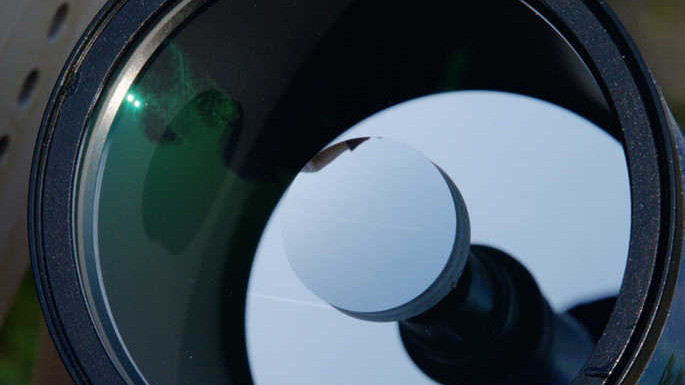The dew must go
Every telescope needs a dew shield. If there is no suitable part available from the manufacturer, you can make one yourself using black foam rubber.
 Unwanted light in the tube: if the dew shield is missing, as with this Schmidt-Cassegrain, it is not only dew that will cause you problems. S. Wienstein
Unwanted light in the tube: if the dew shield is missing, as with this Schmidt-Cassegrain, it is not only dew that will cause you problems. S. WiensteinThe front extension to the tube – usually known as the dew shield – protects the objective lens from the elements, ensuring it does not get colder than the ambient air, since this would lead to the formation of dew. For an even better effect, the dew shield can be heated – for example, a self-made version may use car mirror heating foil or constantan wire. But be careful with the heat generated: even lukewarm is much too much of a good thing and will cause image distortion due to rising warm air.
However, the dew shield can do much more besides: as a lens hood, it blocks stray light from entering from the side, which would brighten the image background. Even faint stray light from the sky above the observation site interferes with the observation of faint objects. Telescopes that are rarely found with a dew shield – such as Schmidt-Cassegrain or Maksutov telescopes – are especially sensitive to stray light. All areas inside a telescope that are visible through an open eyepiece holder should therefore be in the shadow of the dew shield, especially the inner wall of a Newtonian tube in the area opposite the focuser.
Therefore, a dew shield is useful for any telescope, even if it is not commercially available as an accessory.
You can use black foam rubber from a craft shop or a sleeping mat to construct one yourself. Black self-adhesive velvet film on the inside is best, it’s more effective against stray light as it’s darker than blackboard paint. The dew shield’s length should be at least one and a half times the tube diameter, and slightly funnel-shaped. If it does not fit snugly, sewing elastic can help.
Author: Sven Wienstein / Licence: Oculum Verlag GmbH
